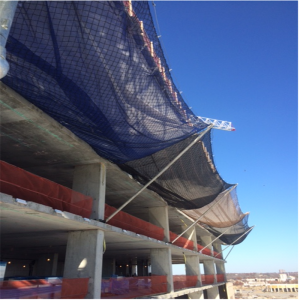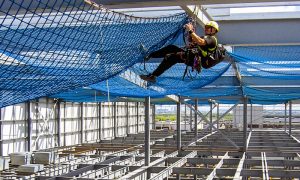Know Your Netting
For maximum protection, use both a netting system and a personal horizontal lifeline for employees.
IN the construction industry, workers are consistently operating in environments where hazards abound. Employers and employees alike rely on state-of-the-art fall protection equipment as they work on various types of structures. With all of the different options for fall protection, it is important to take a look at netting systems.
Netting assures workers they can safely and efficiently do their job, day after day. As a group of five workers in Charleston, S.C., learned, netting can quickly save a life. These particular workers were constructing the Cooper River Bridge when a 4-ton piece of tower wall fell 160 feet. Although the debris netting system being used was designed only to catch a construction worker and/or smaller objects, it miraculously held 8,000 pounds as the workers below got out from underneath the netting.
The falling portion of tower wall not only would have crushed the five employees, but also would have destroyed a part of the unfinished concrete roadway 300 feet below the bridge, thus costing lives, time, and money.
The Need for Netting
As any contractor knows, every possible opportunity should be taken to protect the employees working on a project and civilians below. It is also of great importance to protect the buildings adjacent to the structure and the project being constructed.
According to OSHA, falls are the leading cause of worker fatalities within the construction industry. Between 150 and 200 workers are killed and more than 100,000 are injured annually as a result of falls at construction sites. Because of these high numbers, fall protection is necessary and required any time a fall injury is possible. Besides the threat to life, the damage to buildings and tools is a costly error that can be easily avoided.
Many options are available for contractors to keep their employees safe while working where height is a risk factor. A netting system is one of the most reasonable ways to ensure the safety of both people and equipment. Many different types of nettings exist, allowing contractors to choose one or a combination to best fit the needs of their situation. These netting choices will save the lives of employees; they also protect those on the ground from falling tools, materials, or other debris. These systems can be reused if they are properly cared for, installed, and inspected.


